Birds
Media
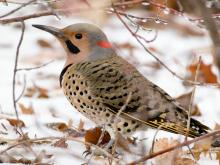
Species Types
Scientific Name
Colaptes auratus
Description
America’s flickers used to be considered three different species, but in the 1980s biologists determined otherwise. Now, our eastern “yellow-shafted” flicker, the “red-shafted” flicker of the west, and the “gilded flicker” of the southwest are all considered just forms of the same species: the northern flicker.
Media

Species Types
Scientific Name
Sayornis phoebe
Description
Eastern phoebes often build their mud-and-plant nests on the side of a house, just under a roof or other overhang. These small flycatchers repeatedly cry out their own name: “FEE-bee! FEE-bee!”
Media
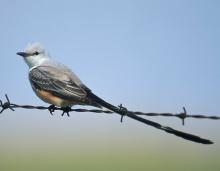
Species Types
Scientific Name
Tyrannus forficatus
Description
One of Missouri’s most breathtaking birds, the scissor-tailed flycatcher captures insects in midair, then flits back to its perch. You’re most likely to see it in summer, in our southwestern prairies.
Media
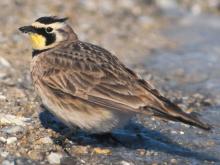
Species Types
Scientific Name
Eremophila alpestris
Description
Horned larks are common in open, plowed crop fields anywhere in Missouri. Their movement against the ground, and their distinctively marked faces and “horns,” can help you see their flocks.
Media

Species Types
Scientific Name
Tringa melanoleuca
Description
One of the more common of about 35 shorebirds that migrate through Missouri, the greater yellowlegs is large, with a slightly upturned bill and long, bright yellow legs.
Media
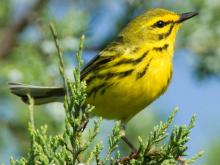
Species Types
Scientific Name
Setophaga discolor (formerly Dendroica discolor)
Description
The prairie warbler has yellow underparts with black streaks on the sides. It lives in dry shrubby glades and old fields with scattered shrubs and red cedars — not in prairies.
Media

Species Types
Scientific Name
Setophaga citrina (formerly Wilsonia citrina)
Description
The male hooded warbler’s yellow face and underparts stand out against its black hood and bib. Look for it in dense thickets in rich bottomland forests of southern Missouri.
Media
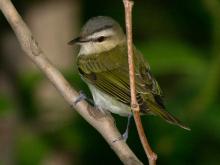
Species Types
Scientific Name
Vireo olivaceus
Description
Singing an incessant series of question-and-answer homilies from dawn to dusk, even through the hottest of summer days, the red-eyed vireo has been called the “preacher bird.”
Media
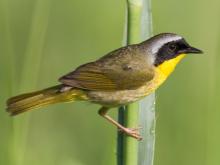
Species Types
Scientific Name
Geothlypis trichas
Description
The male common yellowthroat wears a black mask that contrasts strongly against the bright yellow underparts. The female is olive brown. A common summer resident in Missouri’s marshes and other wet areas.
Media

Species Types
Scientific Name
Geothlypis formosa (formerly Oporornis formosus)
Description
The Kentucky warbler is a common summer resident in Missouri. It prefers moist, wooded areas with plenty of tangles and shrubs. Note its yellow spectacles, black sideburns, and clear yellow breast.
See Also







Media

Species Types
Scientific Name
Hemaris diffinis
Description
The snowberry clearwing is a moth that confuses people because it looks like a bumblebee and flies like a hummingbird!
Media

Species Types
Scientific Name
Hyles lineata
Description
The white-lined sphinx moth sometimes confuses people because it flies, hovers, and eats from flowers like a hummingbird. The adults often fly during daylight hours as well as in the night and are often found at lights.
Media

Species Types
Scientific Name
Darapsa myron
Description
The Virginia creeper sphinx moth is common in woods and brushy areas and comes to lights at night. The larvae eat Virginia creeper and grape leaves.
Media

Species Types
Scientific Name
Perimyotis subflavus (formerly Pipistrellus subflavus)
Description
Tri-colored bats, formerly called eastern pipistrelles, are relatively small and look pale yellowish or pale reddish brown. The main hairs are dark gray at the base, broadly banded with yellowish brown, and tipped with dark brown.
Media

Species Types
Scientific Name
Myotis grisescens
Description
Gray myotises are difficult to distinguish from other mouse-eared bats. A key identifying feature of the gray myotis is that its wing is attached to the ankle and not at the base of the toes. It’s an endangered species.
Media

Species Types
Scientific Name
Myotis lucifugus
Description
The little brown myotis (little brown bat) is one of our most common bats, but populations are declining. White-nose syndrome has taken a heavy toll in northeastern states. This species is now listed as vulnerable across its range.
Media

Species Types
Scientific Name
Myotis sodalis
Description
The Indiana myotis, or Indiana bat, summers along streams and rivers in north Missouri, raising its young under the bark of certain trees. It is an endangered species.
About Birds in Missouri
About 350 species of birds are likely to be seen in Missouri, though nearly 400 have been recorded within our borders. Most people know a bird when they see one — it has feathers, wings, and a bill. Birds are warm-blooded, and most species can fly. Many migrate hundreds or thousands of miles. Birds lay hard-shelled eggs (often in a nest), and the parents care for the young. Many communicate with songs and calls.





















